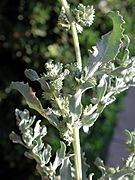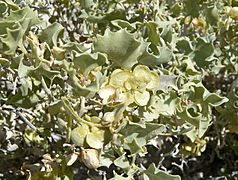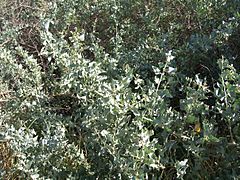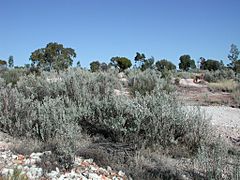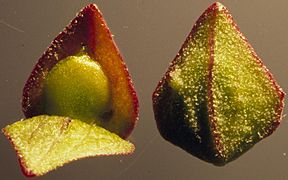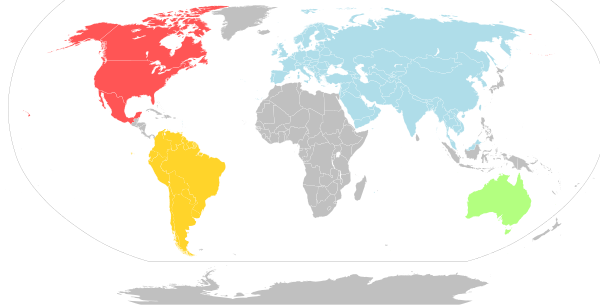Atriplex facts for kids
Quick facts for kids Atriplex |
|
|---|---|
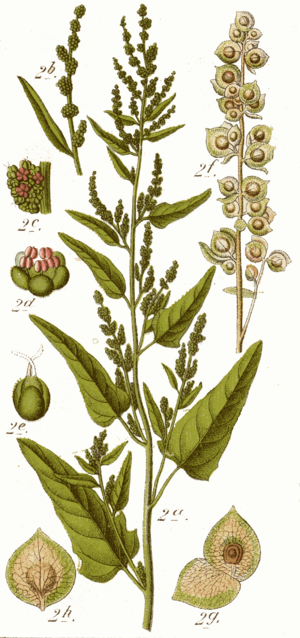 |
|
| Garden orache (Atriplex hortensis) From Sturm & Sturm (1796): Deutschlands Flora in Abbildungen. |
|
| Scientific classification |
|
| Kingdom: | Plantae |
| Clade: | Tracheophytes |
| Clade: | Angiosperms |
| Clade: | Eudicots |
| Order: | Caryophyllales |
| Family: | Amaranthaceae |
| Subfamily: | Chenopodioideae |
| Tribe: | Atripliceae |
| Genus: | Atriplex L. |
| Type species | |
| Atriplex hortensis L.
|
|
| Species | |
|
See List of Atriplex species |
|
| Synonyms | |
|
List
Armola (Kirschl.) Montandon
Blackiella Aellen |
|
Atriplex is a group of about 250 different plant species. They are commonly known as saltbush or orache. These plants belong to the subfamily Chenopodioideae within the family Amaranthaceae.
Atriplex plants are very diverse and can be found all over the world. Many types grow in deserts and along seashores. They are often called halophytes because they can live in salty environments. The name "saltbush" comes from their ability to store salt in their leaves, which helps them grow in salty soil. The name Atriplex comes from Latin and was used by Pliny the Elder for edible oraches.
Contents
What are Atriplex Plants Like?
Atriplex plants can be annual (living for one year) or perennial (living for many years). They can be small herbs, subshrubs, or larger shrubs.
Leaves and Stems
These plants often have special bladder-like hairs on their surface. These hairs collapse and make the plant look silvery, scaly, or mealy. Their leaves usually grow alternately along the branches. Sometimes, they grow in pairs. The leaves can be directly attached to the stem (called sessile) or have a small stem (a petiole). Some leaves even fall off during certain seasons. The shape of the leaf blades can vary a lot; they might be smooth, toothed, or lobed.
Flowers and Seeds
Atriplex flowers grow in the leaf axils (where the leaf meets the stem) or at the ends of branches. They often form spikes or spike-like clusters called panicles. These plants have unisexual flowers, meaning each flower is either male or female. Some species have both male and female flowers on the same plant (called monoecious). Others have male and female flowers on separate plants (called dioecious).
Male flowers have 3 to 5 perianth lobes (like petals) and 3 to 5 stamens (which produce pollen). Female flowers usually don't have a perianth. Instead, they are surrounded by two leaf-like structures called bracteoles. They have a short style and two stigmas (which receive pollen).
After the flowers bloom, the bracteoles often grow larger and thicker. They enclose the fruit but don't stick to it.
Plant Cells and Growth
Most Atriplex species are C4-plants. This means they have a special way of doing photosynthesis that helps them grow well in hot, dry places. A few species are C3-plants, which is a more common type of photosynthesis. The basic number of chromosomes in Atriplex is 9, except for one species, Atriplex lanfrancoi, which has 10.
-
Atriplex patula, female flower with bracteoles and ovule
How Atriplex Plants are Classified
The genus Atriplex was first officially described in 1753 by a famous scientist named Carl Linnaeus. He wrote about it in his book Species Plantarum. The name Atriplex was already used by Pliny the Elder for a plant called orach, or mountain spinach (A. hortensis).
Plant Family Tree
Scientists believe that the Atriplex genus started to evolve about 14.1 to 10.9 million years ago (mya). This was during a time called the Middle Miocene, when the climate became much drier. This dry weather helped the plants that could do C4-photosynthesis to grow and spread quickly.
The Atriplex plants spread across different continents. C4 Atriplex likely came to North America from Eurasia about 9.8–8.8 mya. From there, they spread to South America. Australia was colonized twice by different groups of C4 Atriplex. One group came from Eurasia or America, and another from Central Asia. The second group spread very quickly and became the ancestors of most Atriplex species found in Australia today.
Grouping Atriplex Species
The main species that represents the Atriplex group is Atriplex hortensis. The name comes from an Ancient Greek word, ἀτράφαξυς (atraphaxys), which means "orach."
Atriplex is a very large group with about 250 to 300 species. New species are still being found, like Atriplex yeelirrie, which was described in 2015.
Scientists use molecular studies (looking at DNA) to understand how these plants are related. These studies have shown that some older ways of classifying Atriplex based on how they look weren't always correct. For example, a plant group called Halimione is now considered a separate, but closely related, genus.
Scientists use tools like cladograms to show how different species are related and when they might have split off from each other. These studies suggest that C4 Atriplex plants from Eurasia or Australia first came to the Americas. They appeared in South America first, then spread to North America, and some even moved back to South America later.
| Cladogram of estimated divergences within the genus Atriplex | ||||||||||||||||||||||||||||||||||||||||||||||||||||||||||||||||||||||||||||||||||||||||||||||||||||||||||||||||||||||||||||||||||||||||||||||||||||||||||||||||||||||||||||||||||||||||||||||||||||||||||||||||||||||||||||||||||||||||||||||||||||||||||||||||||||||||||||||||||||||||||||||||||||||||||||||||||||||||||||||||||||||||||||||||||||||||||||||||||||||||||||||||||||||||||||||||||||||||||||||||||||||||||||||||||||||||||||||||||||||||||||
|---|---|---|---|---|---|---|---|---|---|---|---|---|---|---|---|---|---|---|---|---|---|---|---|---|---|---|---|---|---|---|---|---|---|---|---|---|---|---|---|---|---|---|---|---|---|---|---|---|---|---|---|---|---|---|---|---|---|---|---|---|---|---|---|---|---|---|---|---|---|---|---|---|---|---|---|---|---|---|---|---|---|---|---|---|---|---|---|---|---|---|---|---|---|---|---|---|---|---|---|---|---|---|---|---|---|---|---|---|---|---|---|---|---|---|---|---|---|---|---|---|---|---|---|---|---|---|---|---|---|---|---|---|---|---|---|---|---|---|---|---|---|---|---|---|---|---|---|---|---|---|---|---|---|---|---|---|---|---|---|---|---|---|---|---|---|---|---|---|---|---|---|---|---|---|---|---|---|---|---|---|---|---|---|---|---|---|---|---|---|---|---|---|---|---|---|---|---|---|---|---|---|---|---|---|---|---|---|---|---|---|---|---|---|---|---|---|---|---|---|---|---|---|---|---|---|---|---|---|---|---|---|---|---|---|---|---|---|---|---|---|---|---|---|---|---|---|---|---|---|---|---|---|---|---|---|---|---|---|---|---|---|---|---|---|---|---|---|---|---|---|---|---|---|---|---|---|---|---|---|---|---|---|---|---|---|---|---|---|---|---|---|---|---|---|---|---|---|---|---|---|---|---|---|---|---|---|---|---|---|---|---|---|---|---|---|---|---|---|---|---|---|---|---|---|---|---|---|---|---|---|---|---|---|---|---|---|---|---|---|---|---|---|---|---|---|---|---|---|---|---|---|---|---|---|---|---|---|---|---|---|---|---|---|---|---|---|---|---|---|---|---|---|---|---|---|---|---|---|---|---|---|---|---|---|---|---|---|---|---|---|---|---|---|---|---|---|---|---|---|---|---|---|---|---|---|---|---|---|---|---|---|---|---|---|---|---|---|---|---|---|---|---|---|---|---|---|---|---|---|---|---|---|---|---|---|---|---|---|---|---|---|---|---|---|
|
| Some Atriplex Species Examples |
|---|
|
Where Atriplex Plants Live
The Atriplex genus grows almost everywhere in the world. You can find them in warm subtropical areas, mild temperate regions, and even cold subarctic places. The largest number of different Atriplex species are found in Australia, North America, South America, and Eurasia. Many of these plants are halophytes, meaning they are specially adapted to live in dry places with salty soil.
How Atriplex Plants Interact with Nature
Atriplex plants are an important food source for the larvae (caterpillars) of some Lepidoptera (moths and butterflies). You can find a list of these insects that eat Atriplex.
For other creatures like spiders (for example, Phidippus californicus) and other arthropods, saltbush plants offer good places to hide and hunt. This is especially true in areas that don't have many other plants.
Scientists have also suggested that Atriplex plants were a main food source for a giant, extinct kangaroo called Procoptodon goliah. Studies of their bones show they ate plants that used the C4 photosynthetic pathway. Since these kangaroos lived in dry areas, saltbushes were likely a big part of their diet.
How People Use Atriplex Plants
Many Atriplex species are edible. People have been eating them since at least the late Epipaleolithic (Middle Stone Age). Today, the most popular species for eating is usually garden orache (A. hortensis).
Common orache (A. patula) was used as food in northern Europe a very long time ago. Its seeds have been found in ancient villages in Britain, suggesting it was used for cooking. In the biblical Book of Job, a plant called mallûaḥ (likely Mediterranean saltbush, A. halimus) is mentioned as food for people who were social outcasts. Grey saltbush (A. cinerea) has been used as bushfood in Australia by Indigenous people for thousands of years.
Chamiso (A. canescens) and shadscale (A. confertifolia) were eaten by Native Americans. Spearscale (A. hastata) was a food in rural Eurasia.
Modern Uses in Agriculture
Studies have shown that Atriplex species could be very useful in farming. For example, meat from sheep that have eaten saltbush has high levels of vitamin E. This meat is also leaner and has more water than regular lamb. It also looks just as good to buyers as lamb fed on grain. The extra vitamin E is good for the animals' health. It also helps the meat stay fresh and red for longer. This has been seen with old man saltbush (A. nummularia) and river saltbush (A. amnicola). Interestingly, sheep seem to prefer the river saltbush, even though it has more fiber and less nutrition.
A study on A. nummularia found that it has a good amount of nitrogen (2.5–3.5%). This means it could be used as a protein boost for grazing animals if they find it tasty. Another study let sheep and goats eat as much A. halimus as they wanted. It showed that the saltbush provided enough nutrients to add to their diet. However, animals that are pregnant or producing milk might need more nutrients.
Other Uses
Saltbushes are also grown as ornamental plants in landscaping. They can help stop soil erosion in areas along the coast. Old man saltbush (Atriplex nummularia) has also been successfully used to help restore land at old mining sites, like those around Lightning Ridge in Australia.
Images for kids
See Also
 In Spanish: Atriplex para niños
In Spanish: Atriplex para niños


